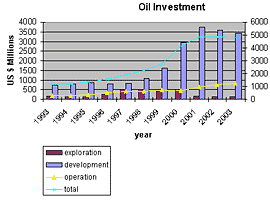 Oil Oil |

The first oil exploration concession was granted by the Portuguese authorities in 1910, but commercial production did not begin until 1956 when the Petroleum Company of Angola (Companhia de Petróleos de Angola--Petrangol) started operations in the Cuanza River Basin. The company later discovered oil onshore in the Congo River Basin and became the operator for most of the onshore fields in association with Texaco, an American company, and Angol (a subsidiary of Portugal's SACOR).
At about the same time, a subsidiary of the American-based Gulf Oil, the Cabinda Gulf Oil Company (Cabgoc), began explorations in the Cabinda area in 1954 and started production in 1968. Production rose from 2.5 million tons in 1969 to 8.2 million tons in 1973, while exports nearly quadrupled in volume. Because of the added benefit of the 1973 oil price increase, the value of oil exports was almost twelve times higher in 1973 than in 1969, and oil finally surpassed coffee as the principal export.
Crude oil production in the early 1980s dipped somewhat as a result of decreased investments.
| By 1983, however, production had rebounded and thereafter continued to set new output records.

As of December 1984, the country's total proven recoverable reserves of crude oil were estimated by Sonangol at 1.6 billion barrels. This amount was considered sufficient to maintain production at 1986 levels until the end of the century.
see tables
Today(link to report on oil/petroleum) the oil industry is still Angola's main economic driving force.
 |

